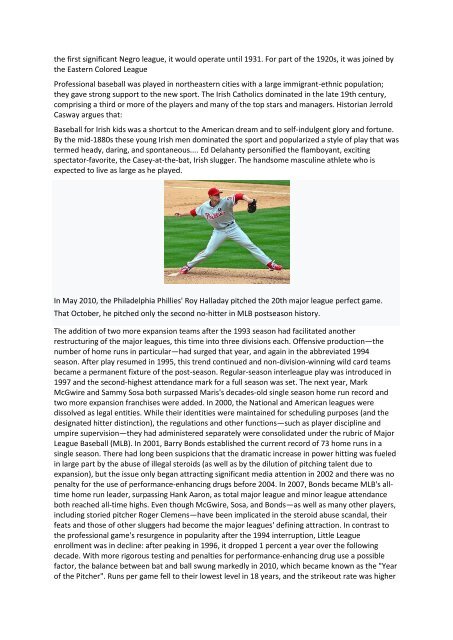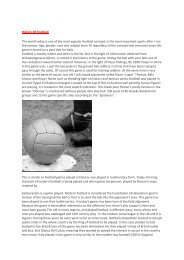Dergi
Create successful ePaper yourself
Turn your PDF publications into a flip-book with our unique Google optimized e-Paper software.
the first significant Negro league, it would operate until 1931. For part of the 1920s, it was joined by<br />
the Eastern Colored League<br />
Professional baseball was played in northeastern cities with a large immigrant-ethnic population;<br />
they gave strong support to the new sport. The Irish Catholics dominated in the late 19th century,<br />
comprising a third or more of the players and many of the top stars and managers. Historian Jerrold<br />
Casway argues that:<br />
Baseball for Irish kids was a shortcut to the American dream and to self-indulgent glory and fortune.<br />
By the mid-1880s these young Irish men dominated the sport and popularized a style of play that was<br />
termed heady, daring, and spontaneous.... Ed Delahanty personified the flamboyant, exciting<br />
spectator-favorite, the Casey-at-the-bat, Irish slugger. The handsome masculine athlete who is<br />
expected to live as large as he played.<br />
In May 2010, the Philadelphia Phillies' Roy Halladay pitched the 20th major league perfect game.<br />
That October, he pitched only the second no-hitter in MLB postseason history.<br />
The addition of two more expansion teams after the 1993 season had facilitated another<br />
restructuring of the major leagues, this time into three divisions each. Offensive production—the<br />
number of home runs in particular—had surged that year, and again in the abbreviated 1994<br />
season. After play resumed in 1995, this trend continued and non-division-winning wild card teams<br />
became a permanent fixture of the post-season. Regular-season interleague play was introduced in<br />
1997 and the second-highest attendance mark for a full season was set. The next year, Mark<br />
McGwire and Sammy Sosa both surpassed Maris's decades-old single season home run record and<br />
two more expansion franchises were added. In 2000, the National and American leagues were<br />
dissolved as legal entities. While their identities were maintained for scheduling purposes (and the<br />
designated hitter distinction), the regulations and other functions—such as player discipline and<br />
umpire supervision—they had administered separately were consolidated under the rubric of Major<br />
League Baseball (MLB). In 2001, Barry Bonds established the current record of 73 home runs in a<br />
single season. There had long been suspicions that the dramatic increase in power hitting was fueled<br />
in large part by the abuse of illegal steroids (as well as by the dilution of pitching talent due to<br />
expansion), but the issue only began attracting significant media attention in 2002 and there was no<br />
penalty for the use of performance-enhancing drugs before 2004. In 2007, Bonds became MLB's alltime<br />
home run leader, surpassing Hank Aaron, as total major league and minor league attendance<br />
both reached all-time highs. Even though McGwire, Sosa, and Bonds—as well as many other players,<br />
including storied pitcher Roger Clemens—have been implicated in the steroid abuse scandal, their<br />
feats and those of other sluggers had become the major leagues' defining attraction. In contrast to<br />
the professional game's resurgence in popularity after the 1994 interruption, Little League<br />
enrollment was in decline: after peaking in 1996, it dropped 1 percent a year over the following<br />
decade. With more rigorous testing and penalties for performance-enhancing drug use a possible<br />
factor, the balance between bat and ball swung markedly in 2010, which became known as the "Year<br />
of the Pitcher". Runs per game fell to their lowest level in 18 years, and the strikeout rate was higher




